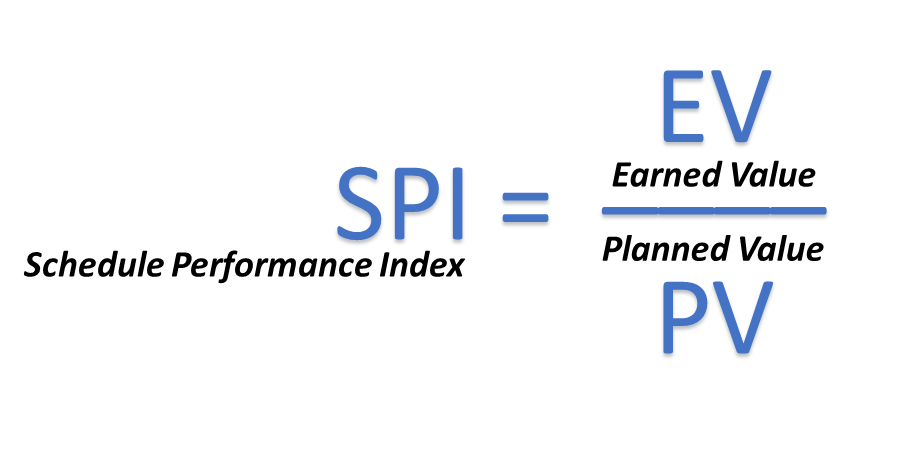Time is money. For project managers, clients, leaders, business owners, stakeholders, and well, anyone in a professional role working collaboratively on a project, “will it be done on time?” is a question packed with meaning. Project managers use proven formulas to provide data-based predictions for schedule and cost, such as the Schedule Performance Index (SPI). Knowing how to use the SPI formula and how to interpret SPI formula calculations is a core requirement on the Project Management Institute (PMI) Project Management Professional (PMP)® exam.

PMP® Exam Formula Cheat Sheet
Learn how to successfully use project management formulas after reading this cheat sheet.
Schedule Performance Index (SPI) Defined
The SPI formula found in PMP® exam questions is grounded in the A Guide to the Project Management Body of Knowledge (PMBOK® Guide) definition:
“The Schedule Performance Index (SPI) is a measure of schedule efficiency, expressed as the ratio of earned value to planned value.”
At the core, the SPI gives insight into the accuracy of the predicted schedule compared to the actual schedule of the project. It’s unlikely that you will be asked to know only the official SPI formula definition on the PMP® certification exam. You should plan to receive questions that measure your understanding of the SPI formula and how to best use the data it provides to manage the overall project schedule.
Schedule Performance Index Formula
Informally referred to as “PMP Schedule Performance Index”, the SPI formula is calculated with the Earned Value (EV) and the Planned Value (PV), or how much work you had planned on being done versus what has been accomplished. Knowing how to calculate each of the values used to determine the SPI is expected as part of successfully answering PMP® exam questions.
The formula for SPI uses Earned Value and Planned Value.


The SPI is calculated by dividing the EV by PV. The resulting SPI value is interpreted based on the variance from 1.

Some may refer to this formula as the “PMP Schedule Performance Index” but that is only due to the inclusion of the tool within the PMP® certification exam. Anyone with project management responsibilities can use the Schedule Performance Index (SPI) calculation to better manage their project schedules.
Interpreting Schedule Performance Index (SPI)
The SPI calculation easily displays how close the work is to progressing within the original schedule estimate. Using the formula SPI = EV / PV, the project manager will have a value of less than 1 (project behind schedule), of 1 (project on schedule), or greater than 1 (project ahead of schedule).
| < 1 | = 1 | > 1 |
| Behind Schedule | On Schedule | Ahead of Schedule |
From the resulting SPI calculation, subtract 1 to determine what percent the work is behind or ahead of the planned schedule.
Schedule Performance Index Calculation Examples
Calculating the SPI is not a complicated mathematical process, it is merely simple division and knowledge of how to interpret the resulting data. Consider these examples from various project management and PMP® exam resources.
Project SPI Example 1
When determining SPI, you are looking for data about the costs and the schedule. Information about the original schedule duration and where the work is within that timeframe. For example, there may be a 3-month project and the project manager is calculating the SPI at the end of month one. There is a project budget of $1,500 and the work is 40% complete. The project manager planned for $500 work of work to be done each month, in other words, a $500/month spend. Is this project behind schedule, on schedule, or ahead of schedule?

The SPI is 1.2 which means the project is .2 or 20% ahead of schedule. The project manager can decide if that pace will continue and adjust the plan with an earlier completion date, or, based on knowledge of the overall effort, know expected resource delays will require the original schedule to stay for the work to be completed on time.
Project SPI Example 2
In this example of a 12-month project with a budget of $100,000, the project manager must determine the SPI at the 6-month mark. To date, $60,000 has been spent for 40% of the work completed; work was distributed evenly each month. Using the SPI formula, the project manager needs to determine how close to schedule the work is progressing.
Actual Cost (AC) = $60,000
Planned Value (PV) = 50% of $100,000 = $50,000
Earned Value (EV) = 40% of $100,000 = $40,000
Schedule Performance Index (SPI) = EV / PV

The project is tracking behind schedule as indicated by the SPI value of .08, which is less than 1.
Cost Performance Index (CPI) and SPI
The SPI is frequently used in conjunction with the Cost Performance Index (CPI). The CPI speaks to budget variance and the SPI provides insight into schedule variance. The SPI and CPI focused question on the PMP® exam are generally not designed to test a student’s mathematical abilities, but rather, the understanding of the data and how to apply it to manage a project to a successful outcome. There is a formula specific to the CPI and those seeking to successfully pass the PMP® exam should know how to calculate the CPI.
The CPI formula for the PMP® exam is calculated with the Earned Value (EV) and Actual Cost (AC).



The SPI and CPI questions on the PMP® exam will require knowledge of how the formulas are calculated, how to interpret the resulting value, and how each is used. SPI and CPI are key concepts in Earned Value Management and are critical concepts for the PMP® certification exam. Students should be prepared to complete calculations of either the SPI or the CPI, or both, as part of the PMP® exam. Additionally, in both the context of the PMP® exam setting and later as a working PMP® certification holder, the Project Manager should be able to interpret what the SPI and CPI mean to a project’s cost and schedule respectively.
Schedule Formulas for PMP® exam preparation
There are 25 formulas that may be included or referenced in the PMP® certification exam, speaking to the range of knowledge a project manager needs in any business setting. The CPI and SPI formulas discussed herein are part of what is known as Earned Value calculations. The PMI® article “How to make earned value work on your project” the top ten items for implementing earned value are listed as:
- Project Requirements
- Work Breakdown Structure
- Change Management Process
- Integrated Project Plan
- Correct Schedule and Budget
- Schedule and Budget Contingency
- Contingency Management
- Cost Collection System
- Accurate Reported Progress
- Management Support
Preparation for the PMP® certification exam should include Earned Value formulas and the connection to project management processes, tools, knowledge areas, and resources.
PMP® Certification Exam SPI Sample Questions
| Question | A | B | C | D |
| You are taking over a project and determine the following: Activity B has an early finish (EF) of day 3, a late finish (LF) of day 6, and an early start (ES) of day 2. Activity L is being done by a very scarce resource. The cost performance index (CPI) is 1.2 and the schedule performance index (SPI) is 0.8. Based on this information, what would you be most concerned about? | Float | Resources | Cost | Schedule |
| You are a project manager working on a high-visibility construction project. Although you have had some weather delays and some of your material expenses were larger than planned, you think you are doing okay. You are going to take some work performance information for your current project. You know that PV = 450, AC = 500 and EV = 375. What are the CPI and SPI, respectively? | CPI = .90 SPI = 1.2 | CPI= .75 SPI = .83 | CPI = 1.2 SPI = .90 | CPI = .83 SPI = .75 |
Studying for the PMP Exam?
Answers
| 1. D. This question tries to integrate a lot of information and test your ability to discern what information is relevant to the question. Though some figures to calculate float are provided (Choice A), there is no information to say that the float is a problem. Most projects have hard-to-get resources (Choice B). The question does not give an indication that having hard-to-get resources is a problem. CPI (Choice C) is greater than 1, so cost is not something to worry about. SPI is less than 1, so choice D is the best answer. 2. B. CPI is calculated as follows: EV/ AC. SPI is calculated as follows: EV/PV. Therefore, CPI is 375/500 = .75, and SPI is 375/450 = .83. |
Conclusion
The SPI is a relatively simple mathematical formula. The accuracy of the data used for the formula, including all work on a schedule for example not just certain parts, has a direct impact on the value of the SPI calculation. The SPI is part of the Earned Value Management tool kit and a powerful measure of the amount of work actually completed on a project. The PMP® credential holder, the PMP® exam taker, and anyone in a project management role should know not only the SPI formula but how to determine what actions are needed from the interpretation of the SPI calculation.
Upcoming PMP Certification Training – Live & Online Classes
| Name | Date | Place |


 New Horizons
New Horizons
 Project Management Academy
Project Management Academy
 Six Sigma Online
Six Sigma Online
 TCM Security
TCM Security
 TRACOM
TRACOM
 Velopi
Velopi
 Watermark Learning
Watermark Learning
 Login
Login




 New Horizons
New Horizons
 Project Management Academy
Project Management Academy
 Velopi
Velopi
 Six Sigma Online
Six Sigma Online
 TCM Security
TCM Security
 TRACOM
TRACOM
 Watermark Learning
Watermark Learning